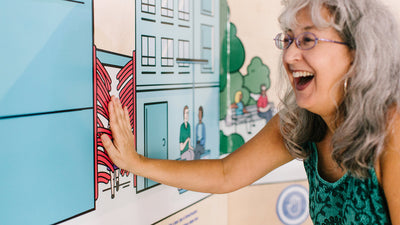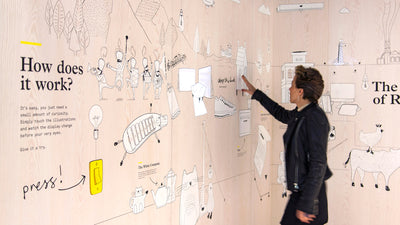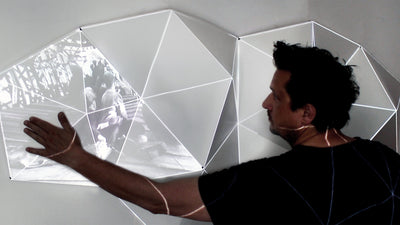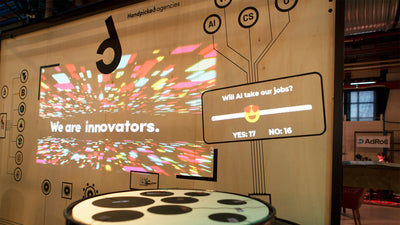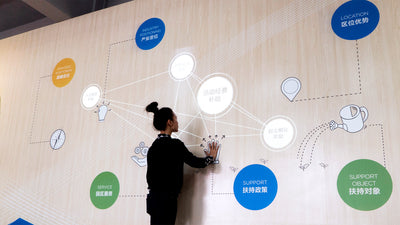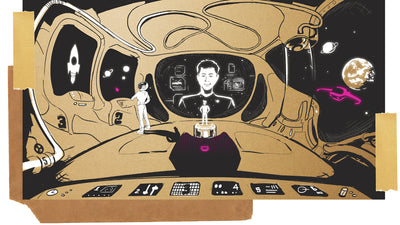Don't Touch the Monsters - A Projection Mapping Installation At A Maker Faire

At Maker Faire Rome 2016, besides having a great chat with Massimo Banzi, we also met the very talented people from Studio Macchinette and had the opportunity to chat with them about their interactive project, 'Don't touch the monsters', which was made with the Pi Cap and Electric Paint, and has been awarded a blue ribbon Maker of Merit from Sherry Huss, VP Maker Media.
Don't touch the monsters from StudioMacchinette on Vimeo.
Hello! Lovely to see you all and this beautiful interactive wall. We've already met, but could you remind us of the story behind Studio Macchinette?
We met in 2012 in a co-working space - Emiliano Pallini was working on his nerd stuff, Roberto Pusceddu was working on his graphics and I (Simona Lombardo) was there, working on my things. We started off playing with a Makey Makey - this was the first interactive approach to work that we shared and it was really, really fun! Then Emiliano showed us Arduino and a lot of new ideas came to us. We realised that it was a lot of fun to interact and sort of contaminate and influence one another because we are three different professionals - each very specific in our fields but sharing a creative mindset. We enjoyed interacting and taking the new ideas that interaction between ourselves gave us to express a concept.
Emiliano is an interactive developer, Roberto is a visual designer specialising in illustration and I am a communication specialist, but I am really into visual art. We tried to get the measure of the team through small projects, understanding that they should be fun and mix our interactive and technological competencies with visual design. The first experiments went very well - we were guided by following a specific line of enquiry which was working with technology while giving lots of importance to manual making. A mixture of digital and analogue approaches inspires and stimulates us - and we find the outputs to be very beautiful too. If you work with your hands, you can give technology a soul.
Another important point is that we don't like to take ourselves too seriously - we share an ironic approach to life, to ourselves - and this is an important element in the alchemy between us. Our friendship is based on irony, but we can be very serious at the same time - like the duality between handmade and digital fabrication. Both can be very silly at times, but also very serious. This is why I think that our projects are often well appreciated in corporate contexts! We have had the chance to do team-building workshops in large companies where participants had to work on corporate issues and important commercial messages. They really enjoyed our creative approach and lateral thinking but also the fact that the underlying concepts were strong and backed up by our technical competency and ability to communicate concepts clearly using visual methods.
Have you exhibited at Maker Faire Rome before?
This is our third appearance at Maker Faire Rome. The first time was in 2013 and we built a wonderful project - a two metre by two metre handmade wooden structure with 256 LDR (Light Dependent Resistor) sensors. It was a huge shelf with lots of little boxes and you had to fill these boxes with polystyrene blocks in order to control a music sequencer. It was really important for us in creating this that the fun we had making the project was translated to the people interacting with it at the Faire. In fact, this first project was fairly well assaulted (with love) by all the kids at the Maker Faire! We were also awarded a blue ribbon by Massimo Banzi, who chose the project as one of his ten favourites on show that year. We were very honoured by this - it was totally unexpected! It was our first time there, it was our first big project and there were 250 other projects so we couldn't believe it.
How did you come up with the idea for the piece that you are showing this year?
The concept for this piece came from an artwork that Emiliano saw from Dalziel and Pow on your website. We saw it and loved it and started to think how we might create a piece using similar principles. At the same time, Roberto (as a visual designer) was fascinated by the idea of Electric Paint and we started to do some experiments with his illustrations and using your paint to make them interactive. We presented some of these experiments at Crack Festival - this is an underground festival of comics and illustration held every year at Forte Prenestino, which is one of the most historic social centres in Rome.
Roberto had the chance to take his illustrations and for each one, we tried to build something interactive behind it. In fact, we are lucky enough to have a room that the organisers reserve for us each year because they know that we always bring something crazy! People look forward to seeing our work each year, so this was the perfect opportunity for us to focus on combining interactive technology with illustration.
We thought it would be interesting to work with infographics too so we're currently working on not only the playful and joyful kinds of outputs that you see here but also on more utilitarian outputs that work in different contexts. We're thinking of information services for museums and companies or an interactive map of a city. Often these are aimed at kids - they are our most enthusiastic customers!
The children here are certainly loving your work! For this piece, what materials and technologies have you used to bring it to life?
The main material for the interactive surface is foam core board with overlaid graphics digitally printed on adhesive vinyl. Behind the foam core panels, there are several Raspberry Pis, each with a Bare Conductive Pi Cap. Each of the Raspberry Pis then communicates with a central laptop running SpaceBrew, a framework written in Node.js and for each Raspberry Pi there is a program based on the Pi Cap data stream example. The central laptop runs a Python script that communicates with the Raspberry Pis via WebSocket and then outputs MIDI messages to Millumin - the video mapping software - which receives them and plays the correct video. The final panel (which triggers audio playback, not video) is entirely autonomous and runs directly on the Raspberry Pi itself with no communication to the central laptop. Can we take this opportunity to thank Incredibox for the beautiful sounds? They supported us and they are so cool! Thanks so much Incredibox!
Were there any challenges in bringing the project to life?
Actually, these were mostly on the structural side, as the code examples are really easy to use. The communication to SpaceBrew is very easy - so no particular difficulties - except for the WiFi yesterday!
Is there anything exciting coming up for Studio Macchinette? What should we be looking out for?
Yes - there are so many projects that we are thinking about right now, especially using the Electric Paint and Pi Cap - stay tuned!
If you want to create your own Projection Mapping project, have a look at the tutorial with the Touch Board or the tutorial with the Pi Cap.
We love it when you share your projects! Post your project on Instagram, YouTube, or Twitter, and make sure to tag @bareconductive or use #bareconductive. You can also send your videos and photos to info@bareconductive.com so we can post them on our site for the world to see.


